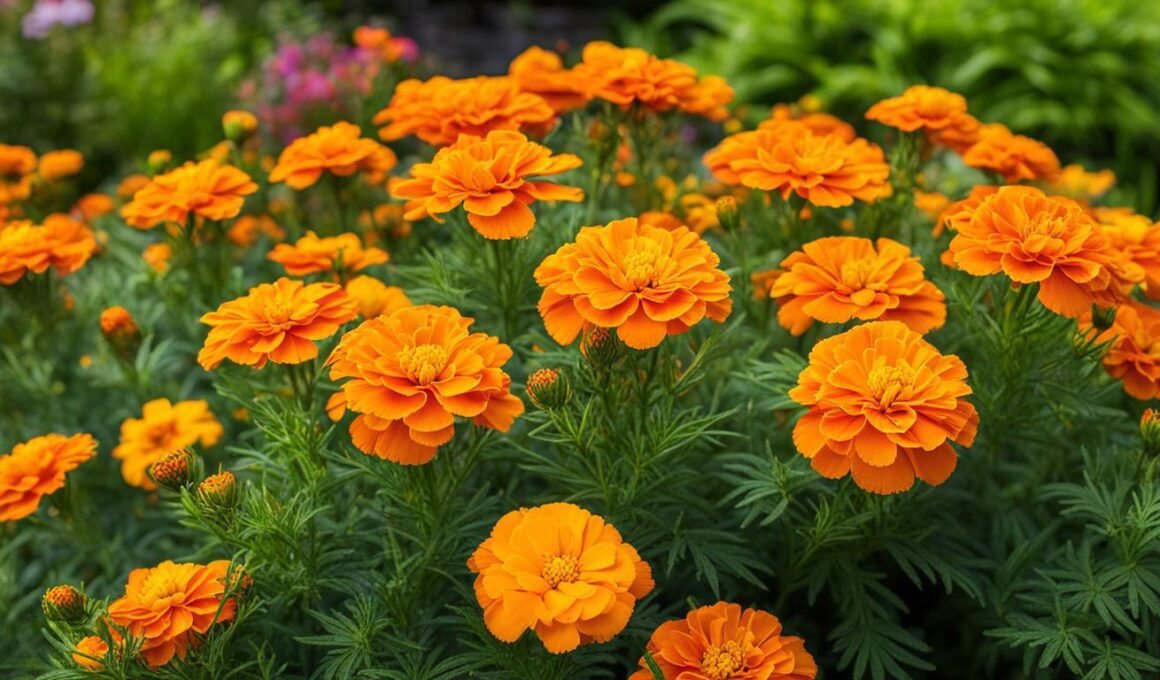Marigolds are a popular flower for gardeners, known for their vibrant colors and ease of care. To fully unlock the potential of your marigold plants perennial, it is important to understand their light requirements, including the color and intensity of light they need. This article will provide you with the necessary information to ensure your marigolds thrive in your garden and elevate your horticultural experience.
Key Takeaways:
- Marigolds are a sun-loving plant that requires full sun for at least 6-8 hours a day to thrive.
- Supplementing their sunlight with artificial light, such as full-spectrum LED lights, can enhance the bloom and color of the flowers.
- Marigolds should be exposed to a minimum of 6 hours of direct sunlight per day to ensure healthy growth and blooming.
- Regularly deadheading the faded flowers promotes continuous blooming and encourages the plant to produce more buds and vibrant blooms.
- Understanding and providing the right light conditions for marigold plants perennial will ensure their healthy growth and maximize their blooming potential.
Understanding the Light Needs of Marigold Plants Perennial
Marigold plants perennial are renowned for their vibrant colors and ease of care in the garden. To ensure the full potential of these beautiful flowers is unlocked, it is essential to understand their light needs. The right color and intensity of light can make a significant difference in the growth and bloom of marigold plants perennial.
Marigolds thrive in sunny conditions, requiring a minimum of 6-8 hours of direct sunlight daily. While they can tolerate partial shade, their blooming capacity and color vibrancy may be reduced. As for the color of light, marigolds do not have a specific preference and can flourish under any color. However, supplementing natural sunlight with artificial light, such as full-spectrum LED lights, can enhance the intensity of their bloom and overall flower color.
The intensity of light is an important factor to consider for optimal marigold growth. Brighter light generally results in more abundant blooms, while dimmer light may lead to fewer blooms or smaller flowers. By providing the right amount of light and finding the perfect balance, you can ensure that your marigold plants perennial thrive and showcase their vibrant beauty in your garden.
img src=”https://seowriting.ai/32_6.png” alt=”light needs of marigold plants perennial”
Factors to Consider:
- Marigolds require a minimum of 6-8 hours of direct sunlight daily.
- Partial shade can reduce blooming capacity and color vibrancy.
- Marigolds can flourish under any color of light.
- Supplementing natural sunlight with full-spectrum LED lights can enhance bloom intensity and flower color.
- Brighter light generally results in more abundant blooms.
“The right balance of light can make all the difference in unlocking the full potential of marigold plants perennial. By understanding their light needs and providing the right conditions, you can ensure vibrant blooms and a stunning garden display.”
Proper Light Exposure for Marigold Plants Perennial
To ensure the healthy growth and blooming of your marigold plants perennial, it is crucial to provide them with the proper light exposure. Marigolds thrive when exposed to a minimum of 6 hours of direct sunlight per day. This can be achieved by strategically planting them in an area of your garden that receives ample sunlight.
For optimal light exposure, it is recommended to plant marigolds in a location that receives morning and late afternoon sun, as these periods tend to have less intense sunlight. This will prevent the plants from getting overexposed and experiencing sunburn or damage. Striking the right balance between light exposure and shade is essential for the health and well-being of your marigold plants perennial.
“Direct sunlight for at least 6 hours a day ensures healthy growth and blooming.”
It is important to note that excessive exposure to sunlight can be detrimental to marigolds. To protect them from intense midday sun, consider providing some shade during the hottest parts of the day. This can be achieved by using shade cloth or positioning the plants near taller vegetation that can provide natural shade.
Proper duration of light exposure:
- At least 6 hours of direct sunlight per day
- Preferably in the morning and late afternoon
- Protect from intense midday sun with shade
By adhering to these guidelines, you can ensure that your marigold plants perennial receive the right amount of light exposure, allowing them to thrive and produce vibrant blooms that will enhance the beauty of your garden.
The Benefits of Deadheading Marigold Plants Perennial
Deadheading, the process of removing spent blooms, is a beneficial practice for marigold plants perennial. By regularly deadheading the faded flowers, you can promote continuous blooming and encourage the plant to produce more buds and vibrant blooms.
Deadheading also helps maintain the overall appearance of the plant, preventing it from becoming leggy and untidy. Additionally, removing the spent blooms diverts the plant’s energy away from seed production, resulting in stronger and bushier plants. It’s like giving your marigolds a makeover, making them look fresh and attractive.
“Deadheading the flowers on your marigold plants is an essential task for maintaining their beauty and prolonging their blooming period. By removing the spent blooms, you are preventing the plant from wasting energy on seed production and redirecting it towards producing more flowers. This not only enhances the visual appeal of your marigolds but also ensures a continuous display of vibrant blooms throughout the season.” – Gardening Expert
Benefits of Deadheading Marigold Plants:
- Promotes continuous blooming
- Encourages the production of more buds and vibrant blooms
- Maintains the overall appearance of the plant
- Prevents the plant from becoming leggy and untidy
- Diverts energy towards stronger and bushier growth
Deadheading is a simple yet effective task that can significantly improve the health and beauty of your marigold plants perennial. By investing a little time and effort in removing the spent blooms, you can enjoy a garden filled with a continuous display of vibrant and beautiful flowers.
Conclusion
Marigolds are a wonderful addition to your garden, bringing vibrant colors and cheer to your outdoor space. By understanding and providing the right light conditions for your marigold plants perennial, you can ensure their healthy growth and maximize their blooming potential.
Regular deadheading is also a crucial practice that will further enhance the continuous bloom and overall appearance of your marigold plants. By removing spent blooms, you encourage the plant to produce more buds and vibrant flowers, while diverting its energy away from seed production, resulting in stronger and bushier plants.
So, unlock the potential of your marigold plants perennial and enjoy a garden filled with vibrant and beautiful flowers. Happy gardening!
How Can I Maximize the Growth and Blooming of Marigold Plants in My Garden?
To maximize the growth and blooming of marigold plants in your garden, ensure they receive at least six hours of sunlight daily. Plant them in well-draining soil and water them consistently. Deadheading the faded blooms will encourage continuous flowering and enhance the beauty of marigold plants.
FAQ
How much sunlight do marigold plants perennial need?
Marigold plants perennial require full sun for at least 6-8 hours a day to thrive, although they can tolerate partial shade.
Do marigold plants perennial have a preference for the color of light?
Marigold plants perennial can thrive in any color of light, but supplementing sunlight with artificial light, such as full-spectrum LED lights, can enhance flower bloom and color.
How intense should the light be for marigold plants perennial?
Brighter light generally results in more abundant blooms for marigold plants perennial.
How much direct sunlight should marigold plants perennial be exposed to?
Marigold plants perennial should receive a minimum of 6 hours of direct sunlight per day for healthy growth and blooming.
How can I prevent overexposure to sunlight for marigold plants perennial?
It is important to strike a balance between light exposure and shade, avoiding overexposure to excessive sunlight to prevent sunburn and damage to the plants.
What is deadheading and why is it beneficial for marigold plants perennial?
Deadheading is the process of removing spent blooms. Regular deadheading promotes continuous blooming, encourages the production of more buds and vibrant blooms, and helps maintain the overall appearance of the plant.
How does deadheading benefit marigold plants perennial?
Removing spent blooms diverts the plant’s energy away from seed production, resulting in stronger and bushier plants.











